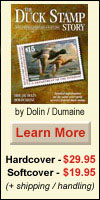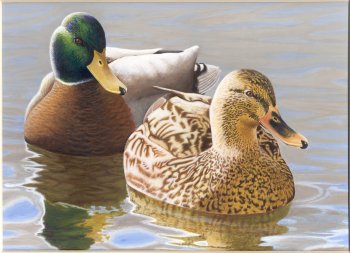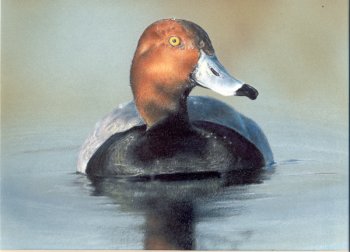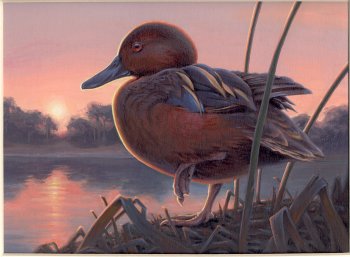 |
10% off on
web orders over $100 |
|
|

|
|
MONTANA YOUTH WINS THE FEDERAL JUNIOR DUCK STAMP CONTEST

April 29, 2002
A portrayal of a mallard duck pair won first place in the Federal Junior Duck Stamp Design Contest held Saturday in Ocean City, Maryland. The contest is sponsored by the U.S. Fish and Wildlife Service.
The acrylic painting, "Mallard Morning," by 18-year-old Nathan Closson of Whitefish, Montana, was judged the top painting among the winners from 50 states plus the District of Columbia and American Samoa. Closson's painting will become 2002-2003 Federal Junior Duck Stamp, which is sold for $5 by the Fish and Wildlife Service's Federal Duck Stamp Office to stamp collectors and conservationists. Proceeds of the Junior Duck Stamp sales are used to support a scholarship program for contest winners.
Closson's conservation message, written on the back of the painting, reads "Now is the time to conserve." His art teacher is Mr. Lonnie Collingsworth at Whitefish High School.
Steven Pate, age 16, of Elk Grove, California, took second place with his prisma/airbrush of a red head. The painting is named "Lone Star." Pate studies at Sheldon High. Deborah George is his art teacher.
Timothy Lamb of Sammamish, Washington, took third with his acrylic called "Cinnamon Sunset," a depiction of a cinnamon teal. The 18-year-old studies at Skyline High School. Daniel Ramirez is his art teacher.
Winning the Junior Duck Stamp design is the culmination of the year long Junior Duck Stamp conservation curriculum used by educators in their classrooms. Each state sends Junior Duck Stamp design entries to a designated point where they are judged by a group of people active in the local wildlife art or conservation community.
State "Best of Show" winning designs are sent to Washington, D.C., where three national winners are chosen by a panel of five judges. The Junior Duck Stamp Contest winner receives a free trip to Washington, D.C., along with the art teacher, a parent and the state coordinator the following October to be honored at the Federal Duck Stamp Contest. The first-place winner also receives a $2,500 scholarship award.
Judges for this year's national Junior Duck Stamp Design Contest were: Jonathan Alderfer, an artist and illustrator; John Fairfield, a wildlife wood sculptor; Wilhelm Goebel, artist and former winner of the Federal Duck Stamp Contest; Jim Tate, ornithologist and science advisor to the Secretary of Interior; and Vaughn Collins, incoming chief of the Federal Duck Stamp Office.
The mallard is the most common wild duck in North America. Most male mallards have a green colored head, a white collar, a yellow bill and a purple breast. The smaller female is mottled with a brown bill. Mallards are omnivores. They eat seeds, mollusks, insects, small fish, tadpoles, freshwater snails, fish eggs, and frogs. These "dabbling ducks" usually don't dive under the water, but just tip their heads under to feed.
For more information on the Federal Junior Duck Stamp Conservation Program and Design Contest, contact Terry Bell, U.S. Fish and Wildlife Service, Federal Duck Stamp Office, 1849 C Street, NW, Room 2058, Washington, D.C. 20240; telephone: 202- 208-4354.
The U.S. Fish and Wildlife Service is the principal Federal agency responsible for conserving, protecting and enhancing fish, wildlife and plants and their habitats for the continuing benefit of the American people. The Service manages the 94-million-acre National Wildlife Refuge System which encompasses more than 535 national wildlife refuges, thousands of small wetlands and other special management areas. It also operates 70 national fish hatcheries, 64 fishery resource offices and 78 ecological services field stations. The agency enforces Federal wildlife laws, administers the Endangered Species Act, manages migratory bird populations, restores nationally significant fisheries, conserves and restores wildlife habitat such as wetlands, and helps foreign governments with their conservation efforts. It also oversees the Federal Aid program that distributes hundreds of millions of dollars in excise taxes on fishing and hunting equipment to state fish and wildlife agencies.
For more information about the U.S. Fish and Wildlife Service, visit our home page at http://www.fws.gov

First Place - Nathan Closson

Second Place - Steven Pate

Third Place - Timothy Lamb |
 Back | News Page
Back | News Page
|



















